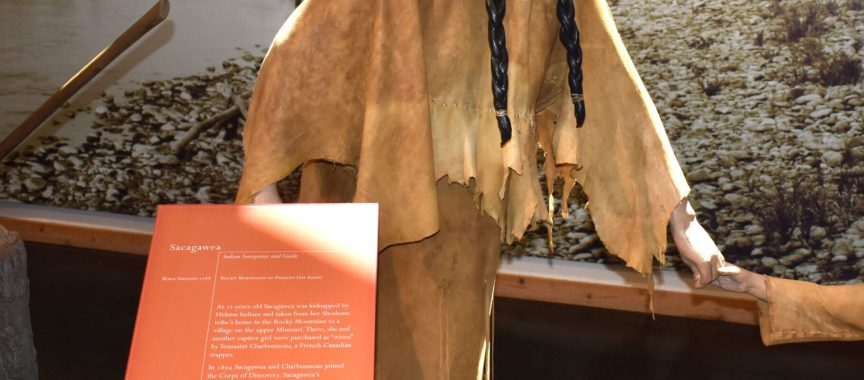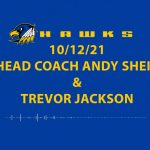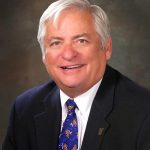News – Sheridan Media
[[{“value”:”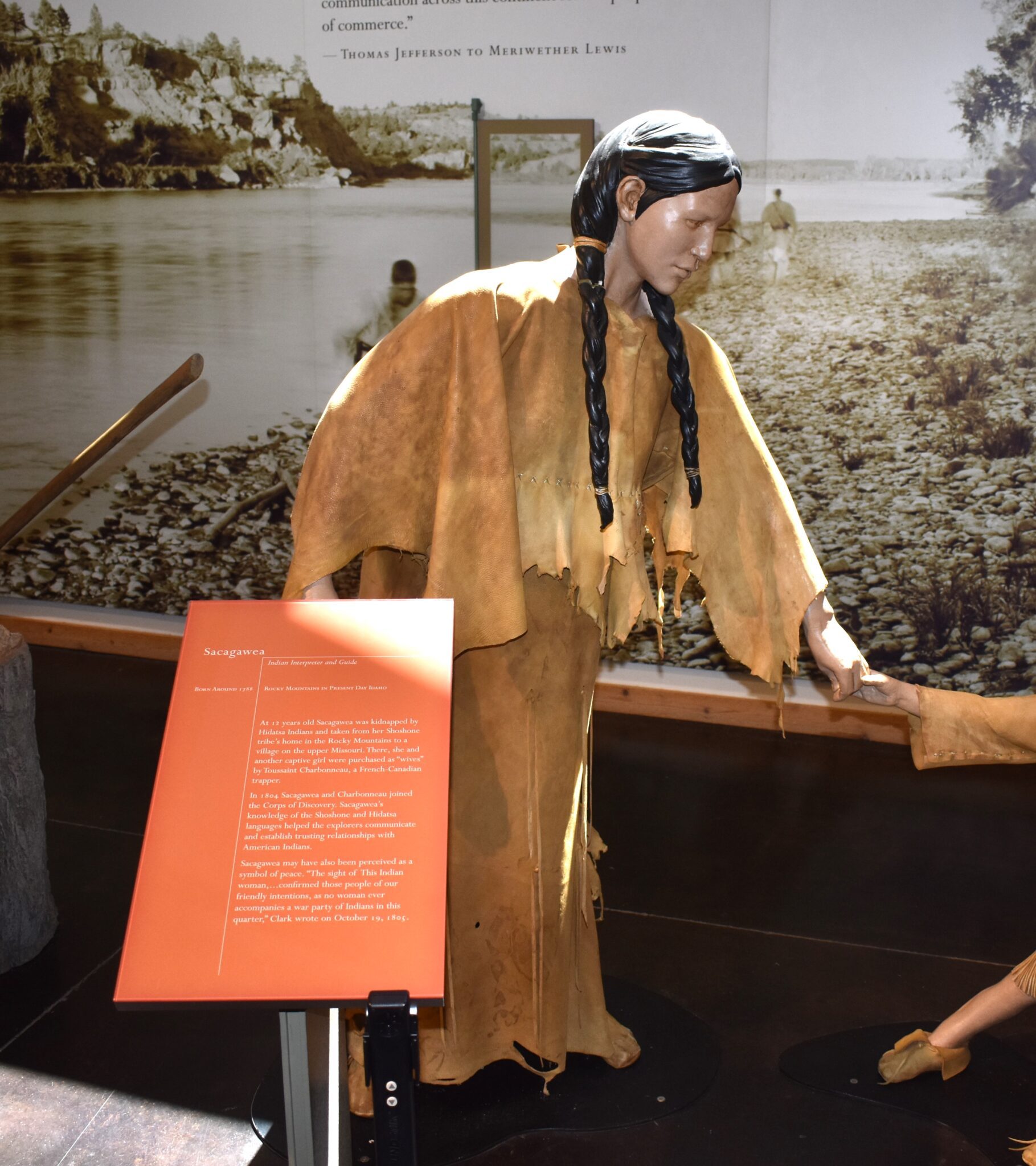
This will be a two, maybe three-part story about the famous Shoshone woman, Sacajawea, the Bird Woman, who guided Lewis and Clark across the vast terrain from what is now North Dakota to the Pacific Ocean. She and her French-trapper husband joined the Corps of Discovery in November of 1804. She was the only woman that was a part of the expedition. Here is the first part of her story.
The Sheridan Post July 30, 1922 – Sacajawea, the Bird Woman, Indian Heroine who guided Lewis and Clark – Of the heroic figures who stand out here and there among the host of trail-blazers who pass in panoramic procession across the pages of American frontier history, none has a greater appeal to human interest than Sacajawea, the Bird Woman, slave child-wife of a dissolute French-Canadian trapper, whose services as guide to the Lewis and Clark expedition across the western wilderness to the Pacific in 1805-1806 have caused her to be idealized by artist and sculptor, by poet, fiction writer and historian.
Without her guidance and assistance, the expedition of Lewis and Clark probably would have failed, for on several occasions she was the direct means of overcoming seemingly insurmountable obstacles. Her sacrifices were many and the hardships she endured, considering that she was but fifteen years of age, seem incredible.
Sacagawea gave birth to her son on February 11, 1805. He was named Jean-Baptiste Charbonneau, and Clark nicknamed him “Pomp,” which means “first born” in Shoshone. When the left Fort Mandan in April of that year, Pomp rode on his mother’s back.
She served as one of the main guides to the expedition after they came into what is now the Montana/Idaho region, where she grew up. Her knowledge of the Shoshone and Hidatsa languages helped them communicate with other tribes as they traveled through the Indian hunting grounds. Once her knowledge of edible plants helped to feed the Corps when rations ran low. Sacagawea’s presence with the tiny babe was valuable as it signified peace and trustworthiness. It made the Corps seem less threatening than an all-male party.
The newspaper story continues.
But, more than the great service she performed, it is the fineness of her character and a loyalty and fidelity attested by every writer who knew her and mentioned her name, that have given her place as the greatest heroine of the American Indians and that lend to her memory a suggestion of the nobility of soul of Joan of Arc. Sacajawea was of the Shoshone tribe and was born on the western slope of the Rocky Mountains about 1790. In her early girlhood, probably at the age of twelve years, she was captured at Three Forks, the source of the Missouri river, by a Minnetaree chief, together with another girl of about the same age, Otter Woman. The chief took his small captives down the Missouri to the Minnetaree village in what is now Dakota, where he made them a part of his family and treated them as he did his own daughters.
A young Mandan warrior, White Grass, fell in love with Sacajawea, it was related, and probably would have won her for his wife had not her father by adoption been reduced in wealth by gambling, to a point where he staked Sacajawea and Otter Woman in a game with the French trapper, Charbonneau, against a fine buffalo horse, and lost the wager. Then the unfortunate girls became the slave-wives of a drunken and often brutal master, who refused to sell Sacajawea on any terms to her lover. The latter, being killed shortly after in a fight between the Mandans and the Arickarees, left her to a hopeless life of a servitude and drudgery.
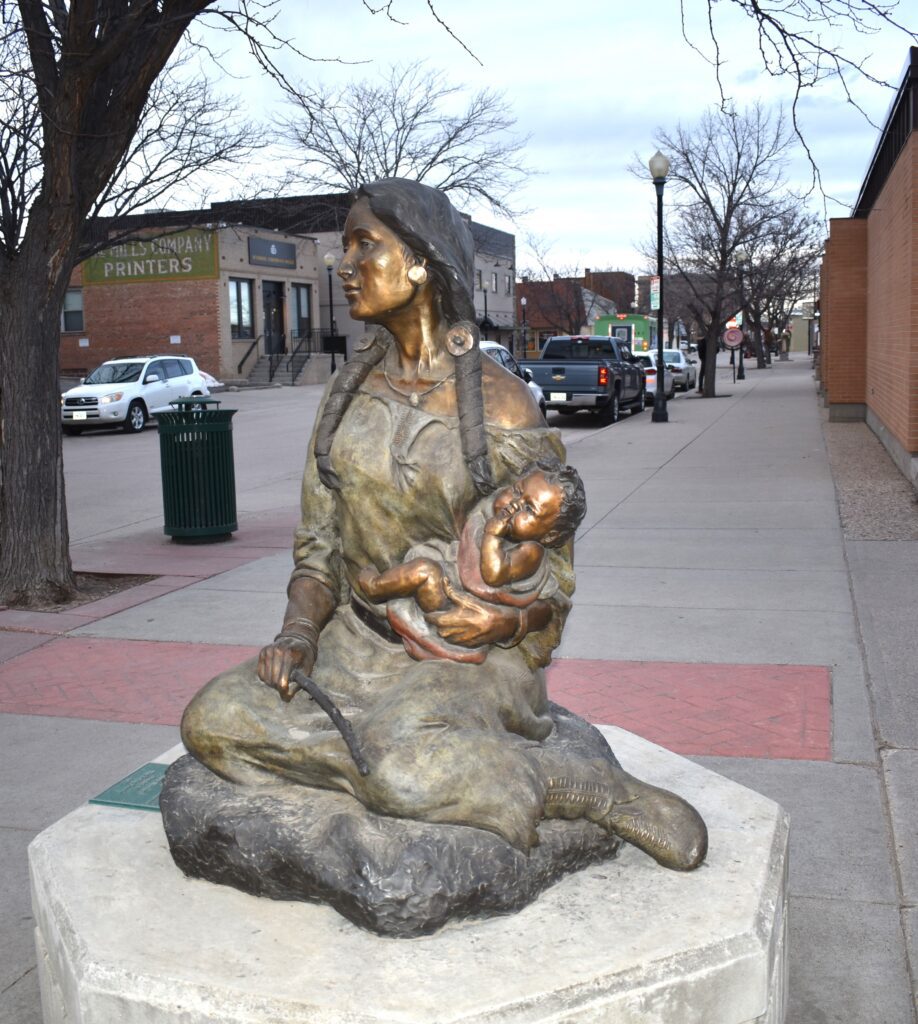
Coming of Lewis and Clark to the Mandan Village Shortly after this occurrence, Charbonneau started on a trapping expedition, and when he returned to the Mandan camp where he made his headquarters, he found the Lewis and Clark expedition at the Indian village on their exploration expedition from St Louis to the Pacific, which was to open to the world the unknown half of the northern American continent. The explorers were in need of an interpreter, and Charbonneau was engaged to accompany the expedition.
Then engages of the British Northwestern Company, wishing to hinder the American explorers, gave Charbonneau a present of considerable value as a bribe to dissuade him from joining Lewis and Clark. This, together with the tact that he had quarreled with Jessaume, another interpreter employed by the Americans and also was not satisfied with the terms upon which he had been engaged, nearly brought Captains Lewis and Clark to a decision to leave him behind.
It happened, however, that Clark had talked with Sacajawea and was so impressed with her knowledge of the passes across the Rockies that he felt she must accompany them. He accordingly patched up the differences with Charbonneau. Had it not been for this, the latter would not have gone with the expedition. At the time the captains left the Mandans Sacajawea was carrying a young babe, which greatly added to her hardships on the journey. Both Captain Lewis and Clark admired the unusual qualities of mind that the young Shoshone girl displayed, as well as her willingness and patience and her remarkable powers of observation and memory.
Often, she rode in the canoe of one or the other of the captains after the expedition left the Mandan where the town of Bismark, ND stands today, the date of their departure being April 7, 1805. The flotilla of the exploration party had not gone far before Sacajawea performed her first signal service. She, with her husband and baby, had been placed in a canoe with the scientific instruments, records and medicines. The frail craft caught in a rapid and filled with water almost instantly. The journals— priceless records of the trip— fell overboard. Charbonneau, thinking only of his own safety, abandoned his wife and child, but the Bird Woman, with courage and appreciation of the value of the papers, recovered them and then was rescued with her baby.
Trained after the custom of Indian women to do all kinds of work, Sacajawea labored with the men in the toilsome journey up the Missouri and when difficulties arose, Captains Lewis and Clark often found her advice and counsel of more benefit than that of any other of the members of the party. Her value increased after they had left the Missouri and faced a search for the unknown passes of the Rocky Mountains.
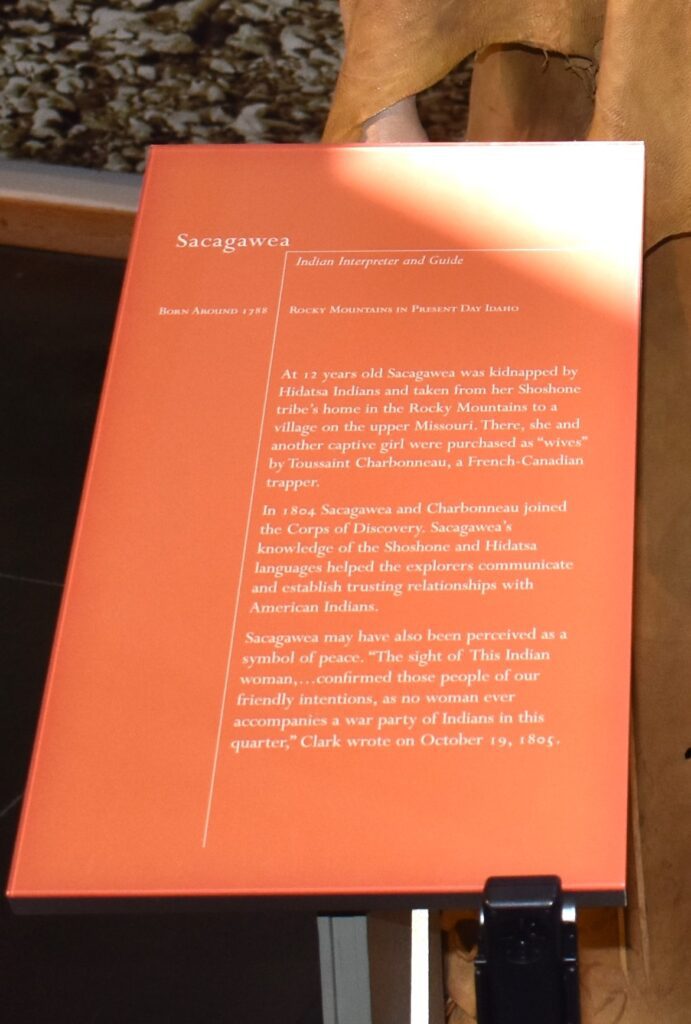
The matter of overland transportation had become vital. The only chance to advance appeared to be to find the Shoshone Indians, win their friendship and purchase horses from them. Sacajawea, coming into a country familiar to her youth, assumed the tremendous responsibility of sole guide.
On July 30 she showed her white companions the place where she had been made prisoner by the Minnetarees. She guided them unerringly up the Jefferson to a landmark that today is historical – the Beaver Head Rock. This point, she told them, was not far from the summer retreat of her own tribe beyond the mountains, and she was certain that they would find the Shoshones after a few day’s travel. True to her prediction, the Shoshones were encountered on August 11th, but the first of that tribe who saw them fled in terror, and warned the others of the party, who beat a hasty retreat. The explorers pursued them slowly and with much toil on foot until the following day, August 12, 1805, which was destined to be the most memorable of the expedition. After struggling over the continental divide that morning they descended upon “a handsome bold creek of clear- cold water, running to the westward.” They stopped to taste for the first time the waters of the Columbia river.

Sacajawea’s leadership had been proved worthy of the trust reposed in her. In obedience to her counsel the party had traced the chief source of the Missouri to the top of the continent’s watershed, and then found the first stream that empties into the distant pacific. Later that day some Shoshone women were encountered, and their meeting with Sacajawea made possible a conference with their chief.
Sacajawea Again Meets Her Brother After Long Parting Sacajawea was called into the conference as an interpreter, she at once recognized Cameahwait, the chief, as her brother whom not seen since childhood. The meeting was a most affecting one. Sacajawea acted as any white girl would have done, throwing her arms about her brother and weeping profusely. The chief was greatly moved, also, and the explorers, when the situation was explained to them, realized that as far as the powerful Shoshones were concerned, their troubles were over. Through Sacajawea the Shoshone chief showed the explorers every courtesy, supplying them with horses and food, and directing them on their way. After that incident Sacajawea became the most important member of the expedition in the opinion of the two captains, but while grateful toward her, they never recompensed her in any manner or expressed their appreciation excepting in the notes of their journals.
One of Sacajawea’s fondest desires was to see the ocean, and she accompanied the expedition to the Pacific. When she was with the Corps at the winter fort near Fort Clatsop, Oregon, she insisted on seeing the “monstrous fish,” a whale that washed up on the beach.
In the next story we will take a look at the return trip, Sacajawea’s son, and where her final resting place is presumed to be.
Photos, except for the bronze statue, were taken at Pompeys Pillar Interpretive Center, Montana, with thanks.
“}]]
Last modified: November 16, 2024

